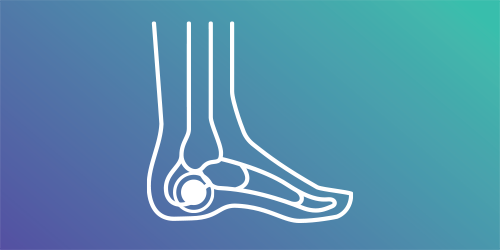
Sever’s disease, growing pains or children growing foot pain, also known as calcaneal apophysitis (inflammation of the growth plate), is a common musculoskeletal condition that affects children and adolescents, typically between the ages of 10 and 14, although it can occur in younger children as well. Of those children who do get foot pain, by far the most common cause is an irritation to the growing area at the back of the heel bone (the Calcaneus) where the strong Achilles tendon attaches to it.
When a baby is born, most of the bones are still cartilage with only some starting to develop into bone. When the heel (calcaneus) starts to develop bone, there is generally one large area of development that starts in the centre of the cartilage heel. This area of bone spreads to ‘fill up’ the cartilage. Another area of bone development (ossification) occurs at the back of the heel bone. These two areas of developing bone will have an area of cartilage between them – this is how the bone grows in size. At around age 16, when growth is nearly complete, these two bony areas fuse together. Sever’s disease is usually considered to be due to damage or a irritation in this area during growth.
If your child is experiencing foot or heel pain or is causing you concern, you may need to book an appointment for a Lower Limb Musculoskeletal Assessment. This Assessment is a series of clinical tests to determine the underlying cause of the pain and discomfort your child is experiencing. At the end of the assessment, our Podiatrist will provide a treatment plan which may include orthotics, supported by exercises and shoe recommendations.
What are the symptoms?
Pain is usually felt at the back and side of the heel bone. Sometimes there may be pain at the bottom of the heel. The pain is usually relieved when the child is not active and becomes painful during sport. Squeezing the sides of the heel bone is often painful. Running and jumping make the symptoms worse. One or both heels may be affected. In more severe cases, the child may limp.
What causes Sever’s disease?
The cause of Sever’s disease is not entirely clear. It is most likely due to overuse or repeated minor trauma that happens in a lot of sporting activities. The cartilage join between the two boney areas at the base of the heel cannot take all the shear stress of the activities. Some children seem to be just more prone to it for an unknown reason – combine this with sport, especially if it is on a hard surface and the risk of getting injuries increases. It can be almost epidemic at the start of some sports seasons, especially winter. At the start of winter, the grounds are often harder, but soften later. Children who are heavier are also at greater risk for developing Sever’s disease.
A tight calf muscle is also common in those children who develop this problem. There is a strong pull from the calf muscles via the Achilles tendon on the small growth plate at the back and the strain that this will place on the cartilage join between them. A pronated foot (a foot rolled in at the ankle) is also more common. A pronated foot creates an unusual twisting of the Achilles tendon causing Achilles Pain that adds a shearing force on the soft bone of the heel in addition to the pulling.
How is Sever’s disease managed?
If your child has Sever’s Disease, the following is suggested:
- Cut back on sporting activities – don’t stop, just reduce the amount until symptoms improve. If the condition has been present for a while, a total break from sport may be needed.
- Avoid going barefoot.
- Our Podiatrist may fit you with some heel raises and possibly an orthotic insole (this reduces the pull from the calf muscles on the growth plate and increases the shock absorption, so the growth plate is not stressed as much).
- Stretch the calf muscles – provided the stretch does not cause pain in the area.
- Massage the calf muscle to help them stretch and relax.
- Strapping or tape is sometimes used during activity to limit the ankle joint range of motion.
- After the pain from Sever’s disease resolves, prevention with the use of stretching, good supportive shock-absorbing shoes and orthotics are recommended to help prevent the return of symptoms.
What are the long-term consequences?
This condition is self-limiting – it will go away when the two parts of bony growth join together. Unfortunately, Sever’s disease can be very painful and limit sporting activity of the child while waiting for it to go away, so treatment is often advised to help relieve the pain.
If your child is experiencing foot or heel pain or is causing you concern, you may need to book an appointment for a Lower Limb Musculoskeletal Assessment. This Assessment is a series of clinical tests to determine the underlying cause of the pain and discomfort your child is experiencing. At the end of the assessment, our Podiatrist will provide a treatment plan which may include orthotics, supported by exercises and shoe recommendations.

